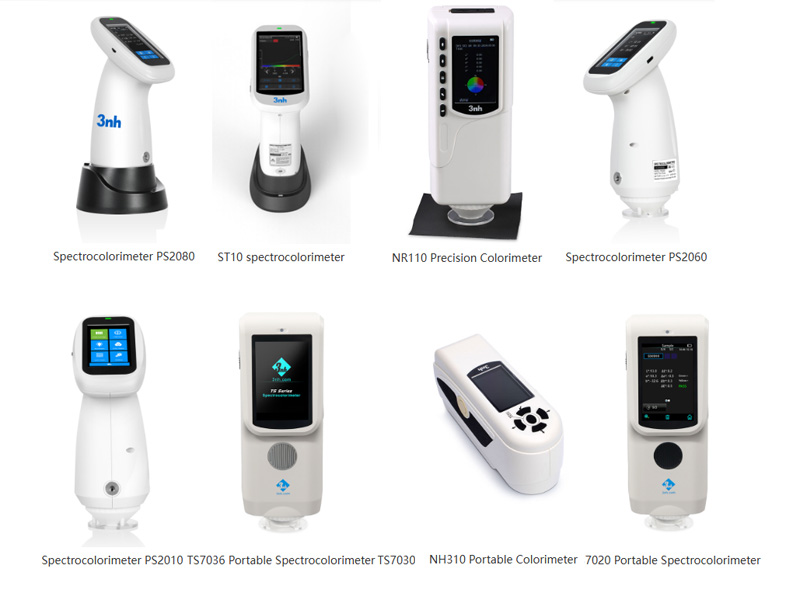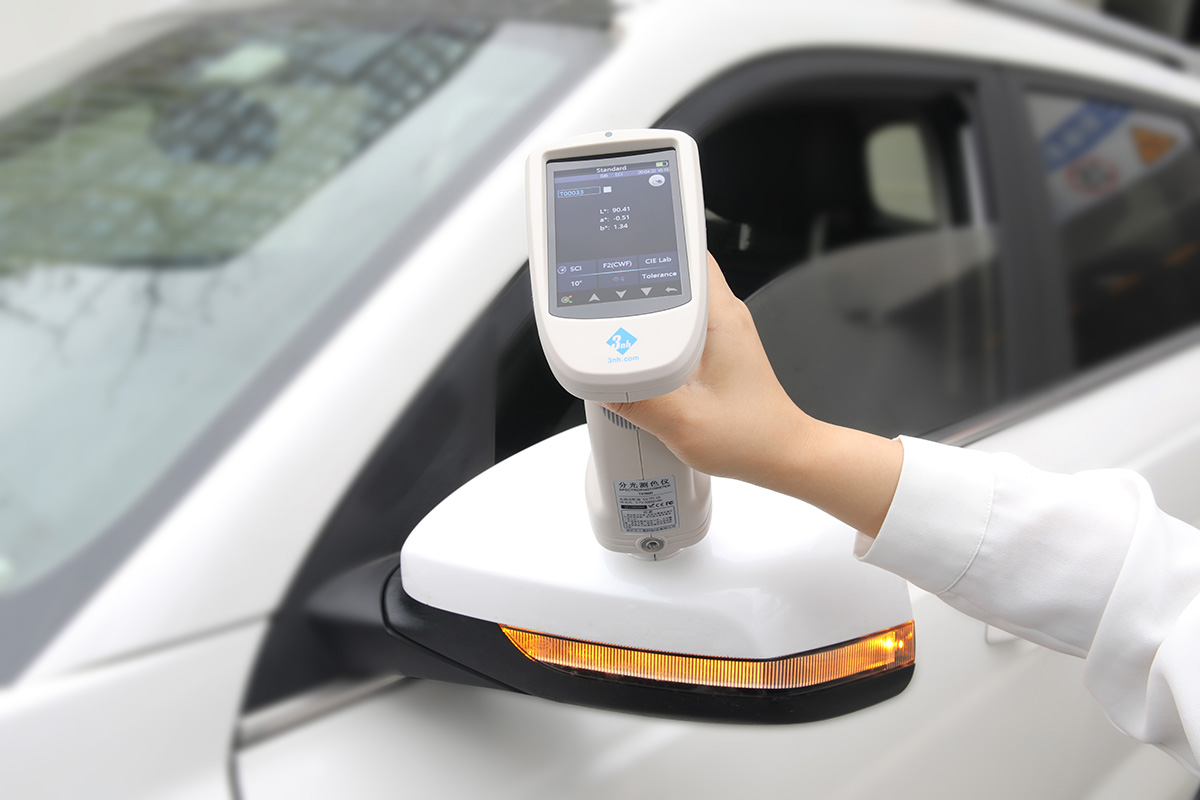Spectrophotometers are measurement products that bring high-performance, easy-to-use colorimeters to the market in a lightweight and compact form. Portable spectrophotometers are measurement products that bring high-performance, easy-to-use colorimeters to the market in a lightweight and compact form.
Product Description
It can be used for color measurement in industries such as automobiles, new materials, new energy, plastics, leather, hardware, textiles, food, pharmaceutical research and development, and aviation.
Main purpose of the instrument
It is ideal for color control of exterior plastics and resins for electronics, vehicle painting, textiles, leather products, etc.
Spectrophotometer TS7700
How to buy a spectrophotometer that meets international standards?
- Determine the need for measurement
What parameters need to be measured? Spectroscopy is primarily based on parameters such as color difference (ΔEΔLΔaΔbΔcΔh). If you want to measure the reflectance spectrum of a color, a spectrophotometer will not be sufficient. Instead, a spectrophotometer is required, which uses a grating to separate the light source and detect the reflectance of each color wavelength.
- Determine accuracy
Because spectrophotometers originated abroad, many people prefer foreign products, believing them to be highly accurate but expensive. This is a well-known fact. Consequently, China spectrophotometers are often overlooked. However, it’s worth noting that domestic spectrophotometers have experienced rapid development in the past two years, and there’s no shortage of leading products. Lantai’s spectrophotometers offer configurable color difference tolerances for PASS/WARN/FAIL judgments. They can store nine target colors, feature user calibration for high accuracy, and offer automatic memory (99 sets) and readout functions. They also feature a digital backlit display, eliminating parallax errors, and an automatic power-off function. These products rival those of foreign spectrophotometers, but are even more appealing not only for their excellent service but also for their affordability compared to foreign counterparts.
- Select the detailed model
Depending on the size of the object being measured, choose a model with a suitable measurement aperture. China spectrophotometers (FRU) include the WF and WR series, which offer a variety of apertures and color difference formulas. They offer reasonable prices, high accuracy, and a wide selection.
To measure whether an object has high gloss, you need to use SCI (including specular reflection light) or SCE (excluding specular reflection light) measurement data and choose the appropriate model.
Basic Principles of Spectrophotometer
Spectrophotometers are designed based on the principle of spectroscopy. They offer high precision and increasing versatility. Because they measure reflectance curves at each wavelength, they are suitable for complex color analysis, though they are relatively expensive. Spectrophotometers have two measurement and observation modes: 0/45 degree and d/8 degree integrating sphere. The 0/45 degree method can only be used to measure smooth surfaces and cannot be used for computer color matching. The d/8 degree integrating sphere method can be used to measure a variety of surfaces and is used for computer color matching.
Main functions of spectrophotometer
Measurements can be taken at any position.
Can simulate a variety of light sources.
The “reflectance curve” of each color point (10nm or 20nm wavelength interval) can be measured.
The use of a xenon lamp allows the instrument to be placed anywhere on the sample surface.
High-precision measurement objects.
The portable and stylish body comes with an illuminated viewfinder.
The portable and stylish body with an illuminated viewfinder allows users to quickly and accurately place the instrument on the object for positioning.
It can be used in medicines, cosmetics, printed materials, building materials, textiles, food and more.
Measure both SCI (specular inclusion) and SCE (specular exclusion) simultaneously.
In just 1.5 seconds, the data from simultaneous SCI and SCE measurements are displayed on the LCD. Unlike conventional spectrometers, there’s no need to manually switch between SCI and SCE modes. Since the measurement area remains unchanged when switching modes, this improves work efficiency and provides stable measurement data. Furthermore, the digital gloss display shows relative gloss.
Can be used in plastics, paints, resins and consumer products
SCI is a measurement method that includes specular reflection. Because of this, it minimizes the influence of the sample surface and is particularly suitable for color quality monitoring and computer color matching.
SCE is a measurement method that excludes specular reflections. The results obtained from this type of measurement are similar to those observed with the naked eye.
Spectrophotometer Buying Guide
Spectrophotometers have more functions than ordinary colorimeters and are more accurate. They are designated for use in certain industries and come in many models. Some models are equipped with liquid containers. You need to check your industry and the types of products you want to test, and then choose a colorimeter based on the industry and product type.
Color Difference Accuracy Selection of Spectrophotometer
You need to know which spectrophotometer to buy. Each industry has different requirements for color difference accuracy, that is, △Eab. If △Eab is between 0-1, then you must choose a higher-precision instrument; these are generally rubber and plastic, coatings and spray painting industries; if you do not need higher accuracy, you can also choose a general spectrophotometer.
Optical structure selection of spectrophotometer
Whether it is a spectrophotometer or a spectrophotometer, the two most common optical structures are the two most widely used in the market: one is the “0/45 degree” and the other is the “d/8 degree integrating sphere”.
0/45 degrees:
“0/45 degrees” is the closest structure to the angle at which the human eye observes things, so the color information measured at this angle is closest to the results observed by the human eye. In addition, 0/45 degrees can only be used to measure smooth surfaces and cannot be used for computer color matching.
d/8 degree integrating sphere:
The d/8-degree integrating sphere is the most commonly used structure for color detection. The measured data is relatively stable. It can be used to measure various surfaces and can be used for computer color matching.
How to choose the light source of spectrophotometer
When choosing a light source for a spectrophotometer, the first things to consider are stability, directionality, lifespan, and the validity of the resulting spectral curve. CIE specifies the spectral characteristics of several different types of typical light sources.
1. D65: Normal daylight (including ultraviolet wavelength region) with a correlated color temperature of 6504K. It is used to measure samples illuminated by sunlight (including ultraviolet radiation).
2. C: Normal daylight (excluding ultraviolet wavelengths) with a correlated color temperature of 6774K. It should be used to measure samples illuminated by daylight in the visible wavelength range (but excluding ultraviolet radiation).
3. A: Incandescent light with a correlated color temperature of 2856K should be used to measure samples illuminated by incandescent light.
Spectrophotometer Operation Performance Selection
In addition, when choosing a spectrophotometer, you should also pay attention to the ease of operation of the instrument and determine the complexity of the operation of the spectrophotometer based on the user group.
Most portable and handheld spectrophotometers now have user-friendly interfaces and are very easy to operate, basically one-click measurement and quick analysis. However, some older models and spectrophotometers with more functions are more complicated to operate and may require professional training to master.
Matching selection of spectrophotometer
In addition to providing a wide range of spectrophotometers, spectrophotometer manufacturers also offer a variety of supporting products, such as quality control software, color database management modules, customer management modules, and color standard data management modules. Hardware-related accessories are also available for measuring specialized samples. These supporting products enhance the colorimeter’s capabilities in quality inspection, management, and production. Even if certain functions are not currently needed, in the long term, system upgrades can be achieved by simply adding supporting products, without being constrained by the spectrophotometer itself.
Selection of test aperture of spectrophotometer
At present, the test aperture of the general spectrophotometer is 4mm or 8mm. If the test product is curved or very small, the test aperture problem needs to be considered; for example:
Large Aperture (LAV): 2.54 cm (1 in)
Medium aperture (MAV): 1.5 cm (0.6 in)
Small Aperture (SAV): 0.75 cm x 1.0 cm (0.3 in x 0.4 in)
Very Small Aperture (VSAV): 0.3 cm x 0.8 cm (0.12 in x 0.31 in)
Stability of spectrophotometers
1. Performance stability: When the spectrophotometer is operating normally, one-click measurement is accurate. When measuring the same location on a sample several times with the same spectrophotometer, different results should not be obtained, or the results should not differ significantly.
2. When using two spectrophotometers of the same model to detect the color of the same part of the same object, the difference between the two spectrophotometers should not be too large.
- The spectrophotometer should not have inaccurate data or large deviations in later measurements due to its long service life. The unstable measurement data due to the service life is also a concern for some users who find maintenance troublesome.
7 Tips for Choosing the Right Colorimeter for Your Industry
Colour accuracy is more important than most people think. Whether you are in print, food production, textiles, or paints. Precise color measurement enables consistency, quality and customer satisfaction. In this case, colorimeters become crucial elements to use.
A colorimeter aids you in the objective assessment of colors, minimizing guess work and human error. Nevertheless, a variety of available models and functions can be confusing.

To help you make a better choice, we will examine seven useful considerations when selecting the right colorimeter in any industry.
1. Understand Your Industry’s Color Requirements
Each industry is special in terms of color measurement requirements. In printing a little variation in shade is disastrous to a whole edition. In food & beverages color is a sign of safety, freshness, and quality.
In the meantime, textile industries require the precise matching between various different fabrics. Determine the level of color accuracy required in your work, before you get one. This requirement can help you reduce the scope of the search to colorimeters that suit your industry.
Learn more:
https://www.threenh.com/Industry_News/7-Tips-Choosing-Right-Colorimeter-Your-Industry.html

